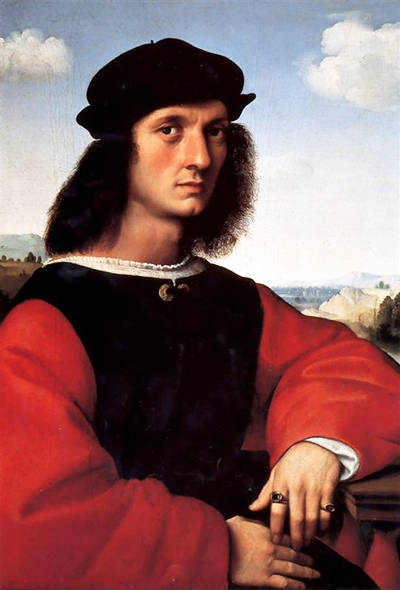The Portrait of Agnolo Doni by Raphael is an oil painting depicting the figure of a young and wealthy cloth merchant. The Palazzo Pitti in Florence, Italy houses the painting.
The High Renaissance artist pays tribute to the marriage of Agnolo Doni to Maddalena Strozzi through the pair of portraits executed in 1506. It was the time when the artist was studying the works of Leonardo da Vinci. Da Vinci's work influenced Raphael, and he includes various elements in the portrait which resemble the structure of Mona Lisa. The artist sets the young man in the first plane against a low horizon which highlights his characteristics.
His hands are one on top of the other, showing his jewelry which suggests his social status. The rings have a ruby which is a symbol of prosperity and a sapphire which is a sign of clarity and purity. Unlike Da Vinci, Raphael's execution creates clarity and balance throughout the painting. The bright and calm image of the background effortlessly integrates a clear psychological representation of the character's personality.
However, the portrait also includes various influences of Raphael's teacher, Perugino such as the stiffness and strength of the lines. Agnolo was a successful and rich fabrics trader. Other portraits painted by Raphael include garments made from the expensive materials sold by Agnolo. Although his wealth is not glamorous, he practices simplistic luxury. Agnolo was passionate about art and jewels and considered himself to be an expert in the field.
The trader's facial features suggest a state of peace and serenity. Raphael uses waves of shadows and lights to emphasize the strength of the trader. The trader sits quietly with one arm resting on the edge of a table, waiting. Raphael uses deep contrasts to show the different layers of the trader's clothing which is an indication of character depth. The golden locks are aligned symmetrically, creating a balance of the outfit which indicates precision and accuracy of thought. The details of his garment are indications of his wealth. Raphael uses smooth and wide brush strokes to create the dynamics of a seemingly static portrait. The eyes of the figure suggest an intensity of thought which exceeds the boundaries of the painting. Viewers cannot decipher what the trader is contemplating.
Although the entire painting comprises balance and symmetry, Agnolo's hair is loose and natural. It shows a contrast between the peace and relaxation of the young trader and what he's experiencing. By using deep and soft colour pallets, the artist highlights Agnolo's mood. He's relaxed but also deeply engaged in contemplation. The painting is 63 x 45 cm in size and executed on wood with oil paint. It marks the start of Raphael's maturity period in terms of art. The Portrait of Agnolo Doni is proof of Raphael's first attempts of showing the reality of the time's society in his works. He uses a combination of elements from Leonardo da Vinci and his mentor to take his work to a superior level of maturity. The balance and clarity depicted in the painting show the artist's appreciation for authenticity.




